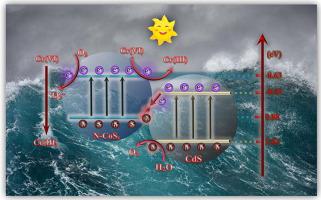Chemical Engineering Journal ( IF 15.1 ) Pub Date : 2021-03-05 , DOI: 10.1016/j.cej.2021.129222 Lixiang Zhang , Luping Feng , Pan Li , Xi Chen , Yuan Gao , Yushuang Gong , Zhongling Du , Sheng Zhang , Anchao Zhang , Guofu Chen , Hua Wang

|
A direct Z-scheme heterojunction has been constructed by loading cadmium sulfide (CdS) on cobalt sulfide doped with nitrogen (N-CoSx) by N2 plasma treatment for efficient photocatalytic Cr(VI) reduction under visible light. It was discovered that the resulting CdS/N-CoSx nanocomposites could present different photocatalytic performances controllably depending on the plasma treatment time and CdS-to-N-CoSx ratios. Especially, the one with 5-min plasma treatment and 8/1 M ratio could exhibit the highest Cr(VI) photoreduction efficiency, which is over four and two folds higher than those of pristine N-CoSx and CdS, respectively. Herein, the plasma-assisted N doping could not only increase the surface wettability and conductivity of CoSx but also decrease its Fermi level for improving the photocatalytic Cr(VI) reduction. More importantly, a direct Z-scheme heterojunction could be constructed by the combination of CdS and N-CoSx with suitable band structures, which could further booster the charge separation and transferring, without sacrificing the redox capacity of photogenerated carriers. The enhanced photocatalytic activity and stability of CdS/N-CoSx nanocomposites could thereby be expected for Cr(VI) reduction, with the efficiency up to 100% within 25 min. Such a direct Z-scheme heterojunction created by the plasma treatment route may promise for the large-scale applications for the removal of various toxic pollutants in the environmental remediation field.
中文翻译:

等离子体辅助将氮掺杂到硫化钴中以装载硫化镉:直接Z方案异质结,可在可见光下有效地光催化还原Cr(VI)
通过N 2等离子体处理将硫化镉(CdS)负载在掺杂有氮的硫化钴(N-CoS x)上,从而在可见光下有效地光催化还原Cr(VI),从而构建了直接的Z型异质结。结果发现,所得的CdS / N-CoS x纳米复合材料可根据等离子体处理时间和CdS与N-CoS x的比例来控制地呈现不同的光催化性能。特别是,经过5分钟等离子处理和8/1 M比率的等离子体可以表现出最高的Cr(VI)光还原效率,是原始N-CoS x的四倍和两倍以上。和CdS。在本文中,等离子体辅助氮掺杂不仅可以提高CoS x的表面润湿性和电导率,而且可以降低其费米能级,从而提高光催化性Cr(VI)的还原率。更重要的是,可以通过将CdS和N-CoS x与合适的能带结构相结合来构建直接的Z型异质结,这可以进一步促进电荷的分离和转移,而不会牺牲光生载流子的氧化还原能力。CdS / N-CoS x的增强的光催化活性和稳定性因此可以预期纳米复合材料可减少Cr(VI),在25分钟内效率可达到100%。通过等离子体处理途径产生的这种直接的Z-方案异质结可能有望在环境修复领域中用于去除各种有毒污染物的大规模应用。



























 京公网安备 11010802027423号
京公网安备 11010802027423号